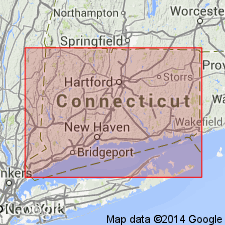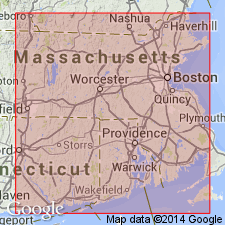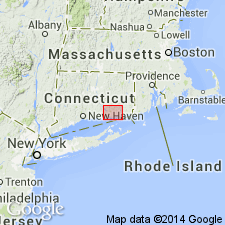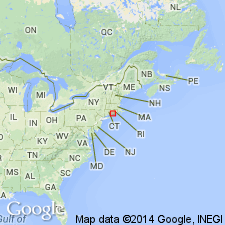
- Usage in publication:
-
- Waterford Complex
- Modifications:
-
- Revised
- AAPG geologic province:
-
- New England province
Summary:
The rocks below 815 m in the Moodus research hole, CT, are correlated with the Late Proterozoic Waterford Group of the Avalon terrane, which is here called Waterford Complex and divided into the Hadlyme and Mamacoke Formations. [This is first use of Hadlyme as a formal name. Previously mapped as Hadlyme belt by Lundgren (1963) and gneiss of Hadlyme by Wintsch (1985) and Wintsch and Alelinikoff (1987).] Sequence is dominated by biotite- and hornblende-bearing plagioclase gneisses, but also contains thin layers of granitic gneiss, amphibolite, and pegmatite.
Source: GNU records (USGS DDS-6; Reston GNULEX).

- Usage in publication:
-
- Waterford Group
- Modifications:
-
- Overview
- Dominant lithology:
-
- Gneiss
- Amphibolite
- AAPG geologic province:
-
- New England province
Summary:
Usage of Waterford Group follows Goldsmith (1980; 1985). Described as a sequence of metavolcanic and metaplutonic plagioclase gneisses and amphibolites that unconformably overlies the Plainfield Formation in the Hope Valley terrane. (Hope Valley and Esmond-Dedham terranes compose the Avalon superterrane of this report.) Thickness is variable; ranges to 3,100 m. Subdivided (ascending) into Mamacoke Formation with its upper Cohanzie Member (first used?), New London Gneiss, and Rope Ferry Gneiss. Age is Late Proterozoic based on U-Pb analyses of zircon and sphene in the Rope Ferry Gneiss (620+/-3 Ma, Wintsch and Aleinikoff, 1987).
Source: GNU records (USGS DDS-6; Reston GNULEX).

- Usage in publication:
-
- Waterford Complex
- Modifications:
-
- Revised
- AAPG geologic province:
-
- New England province
Summary:
Hunts Brook Schist, informally named by Goldsmith (1985), is here formalized and assigned as uppermost unit of Waterford Complex. Includes all schistose rocks on the north and east side of the Lyme dome and equivalent rocks with the type locality as described by Dixon and others (1986 [1968]), Stop 1: CT Guidebook, no. 2, FT F-4). [Rocks were described by Dixon and others as equivalent to Brimfield Schist and Tatnic Hill Formations.] These rocks were also assigned to the Brimfield Schist by Goldsmith (1967) and later correlated with Putnam-Nashoba rocks by Rogers (1985). Schists and gneisses of Huntsbrook Schist here described as strongly layered, well foliated, and blastomylonitic. Overlies Rope Ferry Gneiss (of Waterford Complex) and interpreted as fault rocks derived from that unit. Also included in the Waterford Complex in the Avalon terrane are the underlying Hadlyme Formation, New London Gneiss, and Mamacoke Formation.
Source: GNU records (USGS DDS-6; Reston GNULEX).

- Usage in publication:
-
- Waterford Complex
- Modifications:
-
- Revised
- AAPG geologic province:
-
- New England province
Summary:
Waterford Group is redefined as Waterford Complex because it contains both intrusive and extrusive rocks. Includes both lithodemic orthogneisses and lithostratigraphic paragneisses. In report area, subdivided into Rope Ferry Gneiss (here restricted to belt physically continuous with Goldsmith's (1980) type section) and Hadlyme Formation (new name). Hadlyme subdivided into three lithofacies: North Plain, Jennings Pond, and Mansfield Hollow, all extrusive volcanic facies. Mamacoke Formation not studied.
Source: GNU records (USGS DDS-6; Reston GNULEX).
For more information, please contact Nancy Stamm, Geologic Names Committee Secretary.
Asterisk (*) indicates published by U.S. Geological Survey authors.
"No current usage" (†) implies that a name has been abandoned or has fallen into disuse. Former usage and, if known, replacement name given in parentheses ( ).
Slash (/) indicates name conflicts with nomenclatural guidelines (CSN, 1933; ACSN, 1961, 1970; NACSN, 1983, 2005, 2021). May be explained within brackets ([ ]).

